How to Make Buttermilk and what it is?
Buttermilk is a versatile, slightly tangy dairy product commonly used in baking, marinades, and dressings. While traditional buttermilk was a byproduct of churning butter, the modern version is cultured buttermilk made by fermenting milk with lactic acid bacteria.
Traditional Buttermilk vs. Cultured Buttermilk
- Traditional Buttermilk: In the past, buttermilk was the liquid left over after churning butter from cream. It was naturally fermented, making it slightly tangy and rich in probiotics.
- Cultured Buttermilk: Today, most store-bought buttermilk is made by adding lactic acid bacteria to regular milk. This process thickens the milk and gives it a tangy flavor, making it ideal for cooking and baking.
Why Buttermilk is Essential in Baking & Cooking
Buttermilk plays a crucial role in various recipes due to its unique properties:
✔️ Makes baked goods fluffier – The acidity in buttermilk reacts with baking soda, creating carbon dioxide bubbles that result in lighter, airier textures.
✔️ Adds moisture and tenderness – Buttermilk enhances the texture of pancakes, cakes, and biscuits.
✔️ Boosts flavor – Its tangy taste deepens the flavor of bread, dressings, and marinades.
✔️ Acts as a meat tenderizer – Buttermilk breaks down proteins, making fried chicken and steaks more tender.
The Science Behind Buttermilk’s Tangy Taste
The signature tang of buttermilk comes from lactic acid bacteria. When milk ferments, these bacteria convert lactose (milk sugar) into lactic acid, lowering the pH and thickening the milk. This acidity is what makes buttermilk effective in baking and as a marinade.
Best Methods to Make Buttermilk at Home
Making buttermilk at home is incredibly simple, and there are several methods to achieve that signature tangy flavor. Whether you need a quick fix or prefer a more traditional approach, these techniques will help you create homemade buttermilk with ease.
1. Milk & Vinegar Method (Quickest DIY Buttermilk Recipe)
This is the fastest and most common way to make buttermilk at home.
Ingredients:
✔️ 1 cup of whole milk (or low-fat milk)
✔️ 1 tablespoon of white vinegar (or apple cider vinegar)
Instructions:
- Pour 1 tablespoon of vinegar into a measuring cup.
- Add 1 cup of milk and stir well.
- Let the mixture sit at room temperature for 5–10 minutes until it slightly curdles.
- Your buttermilk is ready to use!
🔹 Best for: Pancakes, biscuits, and cakes.
2. Milk & Lemon Juice Method (Best for Baking)
Lemon juice is another excellent acid to make buttermilk, adding a subtle citrus note.
Ingredients:
✔️ 1 cup of milk
✔️ 1 tablespoon of fresh lemon juice
Instructions:
- Add 1 tablespoon of lemon juice to a measuring cup.
- Pour in 1 cup of milk and stir.
- Let it rest for 10 minutes until it thickens.
🔹 Best for: Cakes, muffins, and dressings.
3. Cream & Yogurt Method (Thicker & Richer Buttermilk Alternative)
For a thicker buttermilk, mix yogurt with milk or cream.
Ingredients:
✔️ ¾ cup plain yogurt
✔️ ¼ cup milk (or heavy cream for extra richness)
Instructions:
- Combine yogurt and milk in a bowl.
- Stir until smooth and well blended.
🔹 Best for: Creamy sauces, marinades, and dips.
4. Fermentation Method (How to Make Buttermilk)
For an authentic buttermilk taste, ferment your own batch.
Ingredients:
✔️ 1 cup of whole milk
✔️ 2 tablespoons of store-bought buttermilk (as a starter)
Instructions:
- Mix the buttermilk starter into the milk.
- Cover and let sit at room temperature for 12–24 hours until thick.
- Refrigerate before using.
🔹 Best for: Drinking, probiotics, and long-term use.
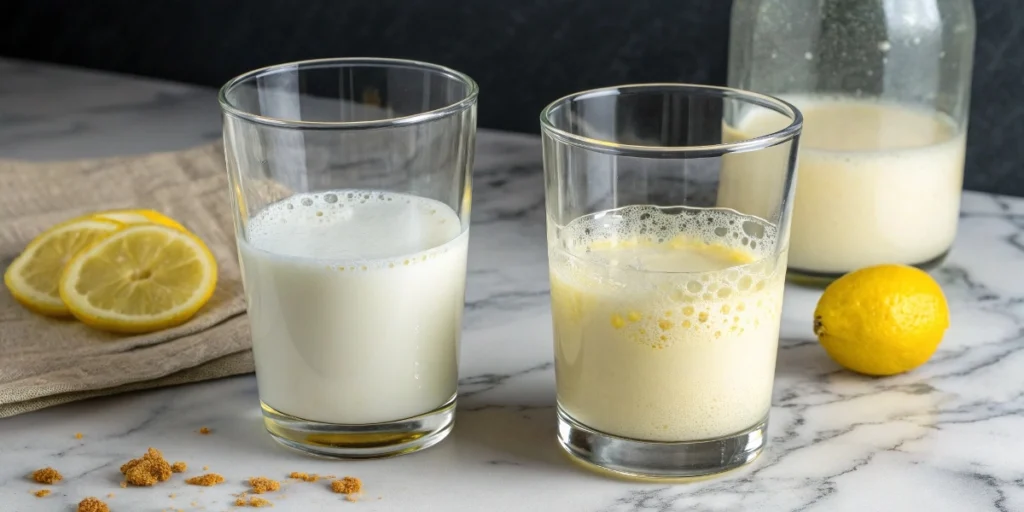
Looking for more homemade dairy alternatives? Check out this guide on Cream Cheese Banana Bread with Cinnamon Topping to see how dairy ingredients enhance baking!
What Type of Milk Works Best for Buttermilk?
The type of milk you use directly affects the texture, flavor, and effectiveness of homemade buttermilk. While most people use regular cow’s milk, there are several alternatives that can also work, depending on your dietary needs and recipe requirements.
Whole Milk vs. Low-Fat Milk: Which is Better?
- Whole Milk: Produces a richer and creamier buttermilk due to its higher fat content. Ideal for baked goods like biscuits and cakes where texture is important.
- Low-Fat or Skim Milk: Works just as well but results in a thinner consistency. Best for dressings, marinades, and light baking.
- Heavy Cream: Can be mixed with yogurt to create a thick, luxurious buttermilk substitute.
For best results, whole milk is the top choice when making buttermilk at home. It provides a perfect balance of fat and acidity, ensuring better texture and moisture retention in recipes.
Can You Use Plant-Based Milk to Make Buttermilk?
If you’re dairy-free or vegan, you can still make buttermilk using non-dairy milk. However, some options work better than others.
Best Plant-Based Milk Options for Buttermilk
✔️ Soy Milk – The best choice for making vegan buttermilk due to its high protein content, which reacts well with acid.
✔️ Almond Milk – Works but has a thinner consistency and mild nutty flavor.
✔️ Oat Milk – A great neutral-tasting alternative but may not thicken as much.
✔️ Coconut Milk – Can be used, but the strong coconut flavor may not be suitable for all recipes.
How to Make Vegan Buttermilk
- Choose a plant-based milk (soy milk works best).
- Add 1 tablespoon of vinegar or lemon juice per 1 cup of milk.
- Stir and let sit for 5–10 minutes until slightly thickened.
Raw Milk vs. Pasteurized Milk for Buttermilk
- Raw Milk: Can be used to make traditional buttermilk through natural fermentation, but it requires more time and careful handling to prevent harmful bacteria growth.
- Pasteurized Milk: The safest and easiest choice for making buttermilk at home. It provides consistent results and is readily available.
If using raw milk, ensure it is sourced from a trusted supplier and stored properly.
How to Make Buttermilk and use it in Recipes
Buttermilk is a versatile ingredient that enhances the texture and flavor of many dishes. Whether you are making breakfast, savory meals, or baked goods, incorporating buttermilk can improve moisture, tenderness, and richness. Here are some of the best ways to use it.
Best Buttermilk Pancakes Recipe
Buttermilk pancakes are known for their fluffy texture and slightly tangy taste. The acidity in buttermilk reacts with baking soda, creating air pockets that make pancakes light and airy.
Ingredients:
✔️ 2 cups all-purpose flour
✔️ 2 tablespoons sugar
✔️ 2 teaspoons baking powder
✔️ 1 teaspoon baking soda
✔️ ½ teaspoon salt
✔️ 2 cups buttermilk
✔️ 2 large eggs
✔️ ¼ cup melted butter
✔️ 1 teaspoon vanilla extract
Instructions:
- In a large bowl, whisk together flour, sugar, baking powder, baking soda, and salt.
- In a separate bowl, mix buttermilk, eggs, melted butter, and vanilla extract.
- Gradually combine wet and dry ingredients, stirring until just mixed. Do not overmix.
- Heat a griddle or non-stick pan over medium heat and lightly grease it.
- Pour ¼ cup of batter per pancake and cook until bubbles form on the surface. Flip and cook for another minute.
- Serve warm with syrup, fruit, or butter.
Fluffy Buttermilk Biscuits Recipe
Buttermilk biscuits are a staple in Southern cuisine. The acidity of buttermilk helps create tender and flaky layers.
Ingredients:
✔️ 2 cups all-purpose flour
✔️ 1 tablespoon baking powder
✔️ ½ teaspoon baking soda
✔️ 1 teaspoon salt
✔️ ½ cup unsalted butter, cold and cubed
✔️ ¾ cup buttermilk
Instructions:
- Preheat oven to 425°F and line a baking sheet with parchment paper.
- In a bowl, whisk flour, baking powder, baking soda, and salt.
- Cut in the cold butter using a pastry cutter or hands until the mixture looks like coarse crumbs.
- Gradually add buttermilk, stirring until the dough comes together.
- Roll out the dough to about ½-inch thick and cut into circles using a biscuit cutter.
- Bake for 12–15 minutes or until golden brown. Serve warm with butter or jam.
Tender Buttermilk Fried Chicken
Marinating chicken in buttermilk tenderizes the meat, making it juicy while ensuring a crispy coating when fried.
Ingredients:
✔️ 4 bone-in chicken pieces (legs, thighs, or breasts)
✔️ 2 cups buttermilk
✔️ 2 cups all-purpose flour
✔️ 1 teaspoon salt
✔️ 1 teaspoon black pepper
✔️ 1 teaspoon garlic powder
✔️ ½ teaspoon paprika
✔️ Vegetable oil for frying
Instructions:
- Place chicken in a bowl and cover with buttermilk. Let it marinate in the refrigerator for at least 4 hours or overnight.
- In another bowl, mix flour, salt, pepper, garlic powder, and paprika.
- Heat oil in a deep pan to 350°F.
- Remove chicken from buttermilk, dredge in seasoned flour, and shake off excess.
- Fry chicken for 10–15 minutes per side until golden brown and fully cooked.
- Drain on paper towels and serve hot.
Looking for another delicious buttermilk-based recipe? Check out this Salted Caramel Banana Bread Recipe to see how buttermilk enhances flavor and texture in baking.
Can You Substitute Buttermilk? (Alternatives & Ratios)
If you don’t have buttermilk on hand, several easy substitutes can replicate its tangy flavor and acidity. These alternatives work well in baking, marinades, and dressings, ensuring your recipes turn out just as delicious.
Using Yogurt as a Buttermilk Substitute
Yogurt is one of the best substitutes for buttermilk because it shares a similar acidity and thickness.
How to Use It:
- Ratio: Use ¾ cup plain yogurt + ¼ cup water or milk to replace 1 cup of buttermilk.
- Best for: Pancakes, muffins, biscuits, and cakes.
Yogurt adds a slightly richer texture, making it an excellent alternative in baked goods.
Mixing Sour Cream & Milk for Buttermilk
Sour cream is another great option due to its acidity and creamy consistency.
How to Use It:
- Ratio: Mix ¾ cup sour cream with ¼ cup water or milk to replace 1 cup of buttermilk.
- Best for: Cakes, dressings, and marinades.
This substitute works well in recipes where extra creaminess is beneficial, such as in ranch dressing or mashed potatoes.
Best Dairy-Free Buttermilk Substitutes
For those who are lactose intolerant or vegan, there are great non-dairy alternatives that mimic buttermilk’s acidity.
Vinegar or Lemon Juice with Plant-Based Milk
- Ratio: Mix 1 cup of soy, almond, or oat milk with 1 tablespoon of vinegar or lemon juice.
- Best for: Vegan pancakes, cakes, and breads.
Soy milk works best because of its higher protein content, which reacts similarly to dairy milk when acid is added.
Coconut Milk & Vinegar
- Ratio: Combine 1 cup of full-fat coconut milk with 1 tablespoon of vinegar.
- Best for: Recipes where a slight coconut flavor is acceptable, like tropical-inspired baked goods.
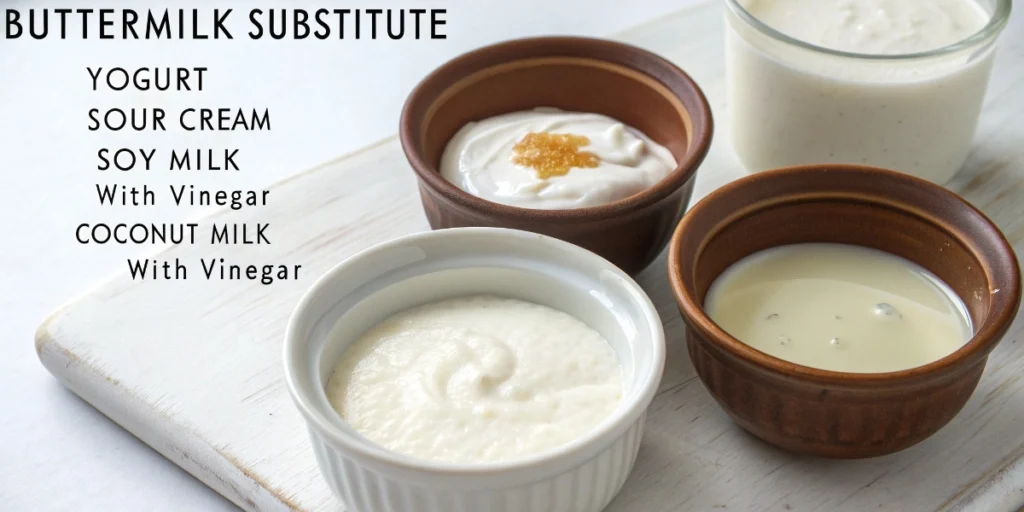
Common Buttermilk Mistakes & How to Avoid Them
Making buttermilk at home is simple, but small mistakes can affect its quality and performance in recipes. Here are the most common errors people make when preparing or using buttermilk, along with tips to avoid them.
1. Using the Wrong Vinegar Type
Not all vinegars work well for making buttermilk. Some have strong flavors that can alter the taste of your recipe.
✔️ Best Choices: White vinegar, apple cider vinegar, and lemon juice.
❌ Avoid: Balsamic, red wine, or malt vinegar, as they can add unwanted flavors.
Fix: Always use a mild acid that won’t overpower the dish. White vinegar or lemon juice is ideal for a neutral flavor.
2. Not Letting Buttermilk Sit Long Enough
When making buttermilk using milk and an acid, it needs time to curdle and thicken properly. Rushing this process can result in a mixture that is too thin and lacks the tangy taste of real buttermilk.
Fix: Let the milk and acid mixture sit for at least 5–10 minutes before using. The longer it sits, the better the consistency.
3. Choosing the Wrong Type of Milk
The type of milk you use impacts the final consistency of buttermilk.
✔️ Best Choices: Whole milk or 2% milk for a rich, creamy texture.
❌ Avoid: Skim milk, as it produces thinner buttermilk with less flavor.
Fix: If you need a thicker buttermilk, use whole milk or add a spoonful of yogurt for extra creaminess.
4. Storing Buttermilk Incorrectly
Homemade buttermilk doesn’t last as long as store-bought versions. Improper storage can lead to spoilage or separation.
✔️ Best Practices for Storage:
- Keep buttermilk in an airtight container.
- Store in the coldest part of the fridge (not the door).
- Shake before use, as separation is natural.
Shelf Life:
- Homemade buttermilk lasts up to 1 week in the fridge.
- Store-bought buttermilk can last 2–3 weeks, depending on the expiration date.
5. Can You Freeze Buttermilk?
Yes, buttermilk can be frozen, but its texture may change after thawing.
✔️ How to Freeze Buttermilk:
- Pour buttermilk into an ice cube tray or freezer-safe container.
- Freeze for up to 3 months.
- Thaw in the refrigerator and shake well before use.
Frozen buttermilk works best for baking but may separate when used in drinks or dressings.
For more kitchen tips, read about Buttermilk recipe
Frequently Asked Questions About How to Make Buttermilk
Many people have questions about making, using, and substituting buttermilk. Below are answers to some of the most common buttermilk-related questions.
1. Can I Use Apple Cider Vinegar to Make Buttermilk?
Yes, apple cider vinegar is a great alternative to white vinegar for making buttermilk. It provides a slightly milder tang and works well in most recipes.
✔️ Ratio: Use 1 tablespoon of apple cider vinegar per 1 cup of milk.
✔️ Best for: Baking, marinades, and dressings.
If you prefer a neutral taste, white vinegar is the better choice.
2. Is Homemade Buttermilk as Good as Store-Bought?
Yes, homemade buttermilk works just as well in most recipes. However, there are a few differences:
| Feature | Homemade Buttermilk | Store-Bought Buttermilk |
|---|---|---|
| Tangy Flavor | Mild | Stronger, more pronounced |
| Consistency | Thinner | Thicker and creamier |
| Shelf Life | 5–7 days | 2–3 weeks |
| Best for | Baking, marinades | Drinking, baking, marinades |
For baking, homemade buttermilk is an excellent substitute. However, if you need buttermilk for drinking or probiotic benefits, store-bought cultured buttermilk is the better option.
3. Is It Better to Make Buttermilk with Lemon Juice or Vinegar?
Both work well, but it depends on the recipe.
✔️ Lemon Juice: Best for recipes where a hint of citrus complements the flavors (e.g., cakes, muffins).
✔️ White Vinegar: Best for neutral-flavored dishes like biscuits, pancakes, and marinades.
✔️ Apple Cider Vinegar: Offers a mild tang and works in almost any recipe.
4. What is the Ratio of Milk and Vinegar to Make Buttermilk?
The standard ratio is:
✔️ 1 cup of milk + 1 tablespoon of vinegar or lemon juice
This formula works for most baking and cooking needs. If you need more buttermilk, simply scale up the ingredients while maintaining the same ratio.
5. What Do I Use If I Don’t Have Buttermilk?
If you’re out of buttermilk, try these quick substitutes:
✔️ 1 cup milk + 1 tablespoon vinegar/lemon juice (quick and easy)
✔️ ¾ cup yogurt + ¼ cup water/milk (thicker consistency)
✔️ ¾ cup sour cream + ¼ cup water/milk (rich texture)
✔️ 1 cup plant-based milk + 1 tablespoon vinegar/lemon juice (vegan alternative)
These options will maintain the acidity needed for baking and cooking.
6. How to Make Buttermilk?
There are four main ways to make buttermilk at home:
- Vinegar Method: 1 cup milk + 1 tablespoon white vinegar
- Lemon Juice Method: 1 cup milk + 1 tablespoon lemon juice
- Yogurt Method: ¾ cup plain yogurt + ¼ cup water or milk
- Cultured Buttermilk Method: 1 cup milk + 2 tablespoons store-bought buttermilk (let sit for 12–24 hours)
Each method works well, but the vinegar and lemon juice methods are the quickest.
For more ingredient substitutions, check out this guide on Banana Bread Recipe Without Butter to learn how to swap ingredients in baking.
Fun Buttermilk Facts & Historical Origins
Buttermilk has been a staple ingredient in kitchens for centuries, evolving from a simple byproduct of butter-making into a widely used ingredient in baking, cooking, and even beverages. Here are some fascinating facts about buttermilk, its history, and its unique benefits.
1. The Origins of Buttermilk: A Byproduct Turned Culinary Staple
- Traditional buttermilk originated as the liquid left over after churning butter. Before refrigeration, this liquid would naturally ferment, creating a tangy, probiotic-rich drink.
- Ancient cultures, including those in India, the Middle East, and Europe, consumed buttermilk for its digestive benefits and cooling properties.
- In the United States, buttermilk became popular in Southern cooking, where it was used in biscuits, cornbread, and fried chicken recipes.
2. Buttermilk Around the World
Different cultures have their own versions of buttermilk:
- India: Buttermilk (chaas) is a spiced yogurt-based drink used as a cooling beverage.
- Scandinavia: Known as “kærnemælk,” it is consumed as a drink or used in baking.
- Middle East: Often used in savory dishes and mixed with herbs.
- United States: Primarily used for baking, cooking, and marinades.
3. Does Buttermilk Really Help with Digestion?
Yes! Buttermilk contains lactic acid bacteria, which are beneficial probiotics that help with:
✔️ Improving gut health by promoting healthy digestion.
✔️ Reducing bloating and aiding in lactose digestion (fermented dairy is easier to digest).
✔️ Boosting hydration, especially in hot climates.
Cultured buttermilk is particularly good for digestive health due to its probiotic content.
4. Buttermilk in Superstitions & Folklore
- In some rural communities, buttermilk was believed to bring good luck when splashed at the entrance of a home.
- Farmers used buttermilk to repel pests in gardens, believing its acidity deterred insects.
- It was also once considered a remedy for sunburn, as people applied it to soothe the skin.
5. Why Buttermilk is a Secret Ingredient in Southern Cooking
Southern chefs swear by buttermilk because it:
✔️ Makes biscuits fluffy due to its acidic reaction with baking soda.
✔️ Tenderizes fried chicken, breaking down proteins for juicier meat.
✔️ Adds a tangy richness to cornbread and pancakes.
No Southern kitchen is complete without a bottle of buttermilk!
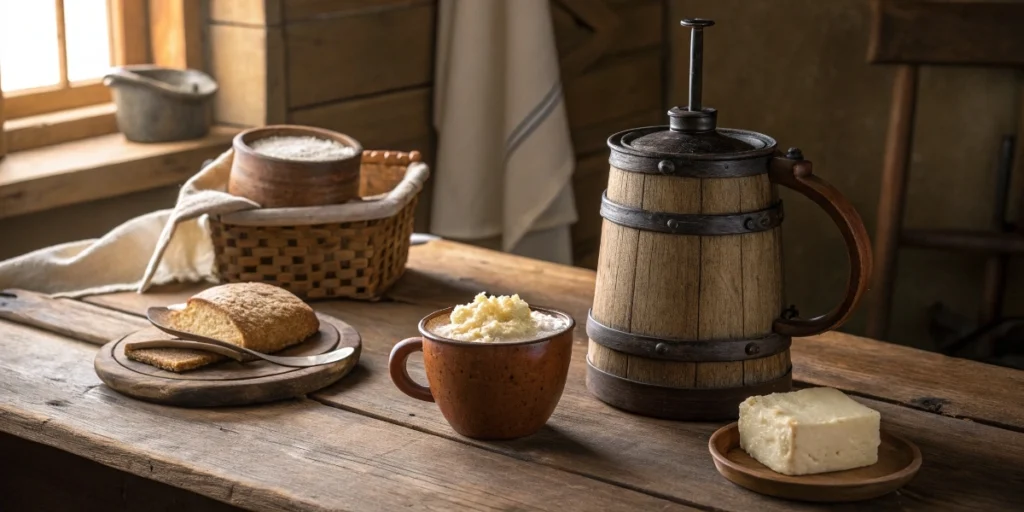
For more Southern-style baking tips, check out this guide on The Secret to Good Pancakes to learn how buttermilk enhances breakfast favorites.
Conclusion & Final Tips for Perfect Buttermilk
Buttermilk is a simple yet essential ingredient in baking, cooking, and marinades. Whether you’re using it for fluffy pancakes, tender biscuits, or crispy fried chicken, knowing how to make and substitute buttermilk ensures you never have to skip a recipe.
Which Method is Best for Your Needs?
- Need a quick buttermilk substitute? Use milk + vinegar or lemon juice (ready in 10 minutes).
- Want a thicker consistency? Mix yogurt or sour cream with milk.
- Prefer the traditional way? Ferment your own buttermilk using a starter culture.
- Looking for a dairy-free alternative? Try soy or almond milk with vinegar.
Quick Recap: Key Takeaways for Making Buttermilk
✔️ Buttermilk enhances fluffiness, moisture, and flavor in baked goods and fried foods.
✔️ The standard ratio for DIY buttermilk is 1 cup milk + 1 tablespoon vinegar/lemon juice.
✔️ Store homemade buttermilk in the refrigerator for up to one week or freeze for later use.
✔️ Plant-based buttermilk works well in vegan recipes, but soy milk is the best option for acidity.
✔️ Buttermilk is a key ingredient in Southern cooking, especially for biscuits and fried chicken.
By mastering these buttermilk techniques, you’ll always have the perfect ingredient on hand for any recipe.
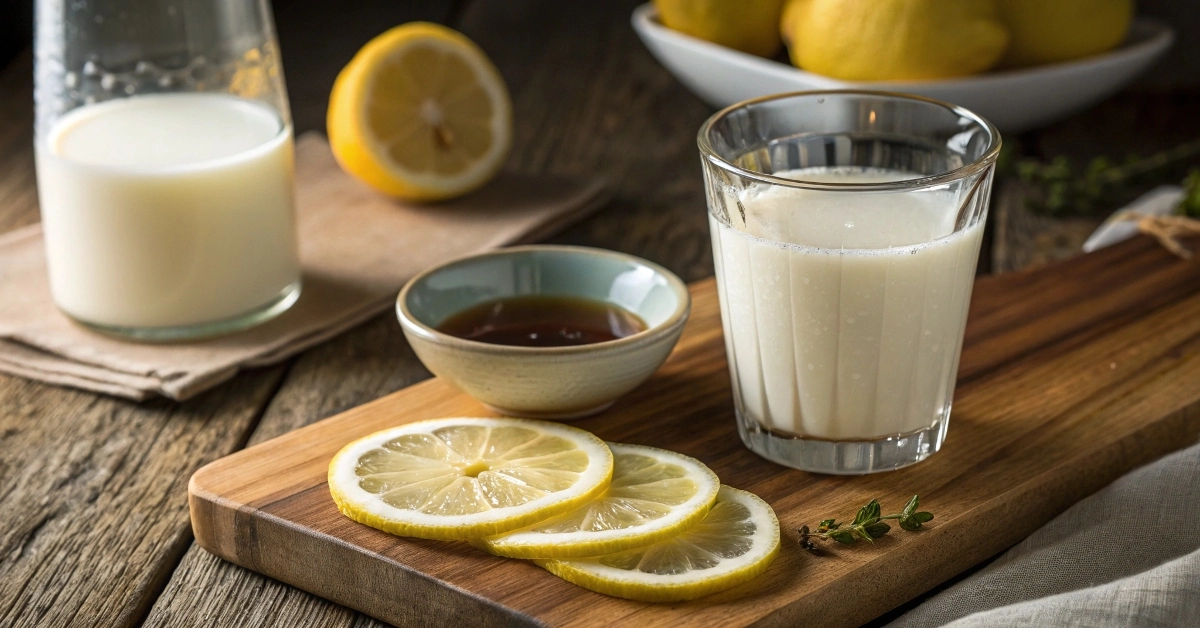
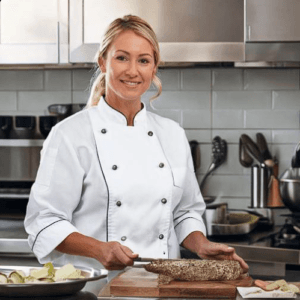
1 thought on “How to Make Buttermilk at Home (Best & Easy Methods)”